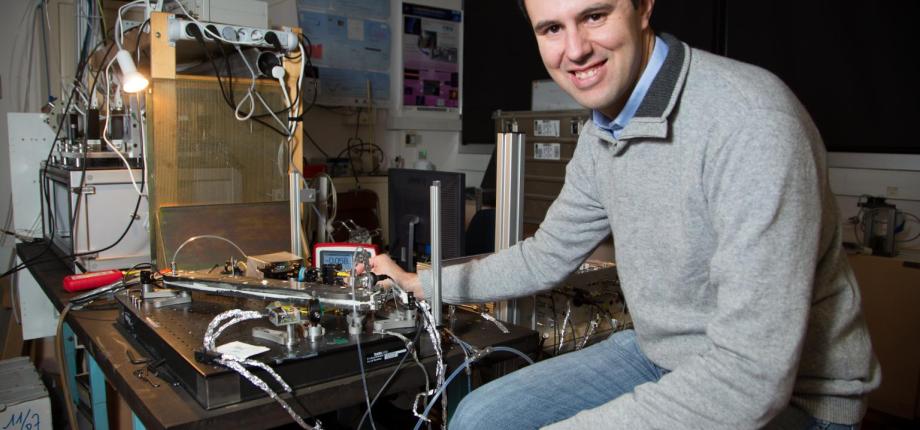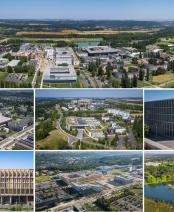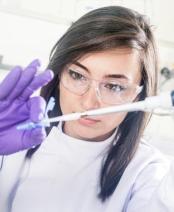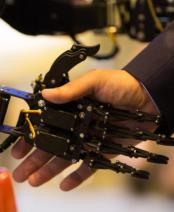Interview with Olivier Guaitella, expert in CO2 recycling by plasma

You are a research engineer at the Laboratory of Plasma Physics (LPP*), expert in CO2 recycling by plasma. Could you tell us about your research work?
My work focuses on the use of plasmas to activate the carbon dioxide molecule CO2 and succeed in using it as a raw material. This is a sub-theme of a more global issue, which is the recycling and recovery of CO2. Everyone knows today that the reduction of CO2 emissions is essential in the fight against global warming.
Why recycle CO2 instead of burying it underground, for example, as some people propose?
I think that leaving future generations with underground CO2 sequestration fields is a very uncertain alternative, technically complex, acidifying the soil and potentially releasing other contaminants. On the other hand, if we are able to convert renewable electrical energy (wind, photovoltaic, etc.) into chemical energy by transforming CO2 into molecules with a higher energy density (e.g. ethanol or methanol), we win on both counts: on the one hand, this makes it possible to recycle CO2 into energy before it is released into the atmosphere, and on the other hand, it allows us to store renewable energies in order to transport this energy in liquid form.
So, we can " "light two candles with one flame": reduce pollution and deploy renewable energy on a larger scale thanks to new storage possibilities!
Yes, but the difficulty is that CO2 is an extremely stable molecule that reacts very badly chemically. When CO2 is split into carbon monoxide CO and atomic oxygen O, the latter tend to recombine into CO2. This is why converting CO2 into a molecule with a higher energy density is difficult and very costly at the moment.
Numerous technologies are being explored to either reduce CO2 emissions at the source or to trap and/or convert the CO2 molecule. Researchers in various fields are working on this. Biologists are using plants (rape, beetroot) or algae that feed on CO2 to convert carbon dioxide emissions into biofuel. Chemists are working on thermal catalysis or electrolysis. And we physicists believe that cold plasmas have a role to play.
We can see that scientists are looking for a solution to recycle CO2. What is your proposal?
Cold plasmas, which are partially ionized gases, have the potential to convert CO2. The special feature of this type of plasmas (also called non-thermal plasmas) is that the electrons, ions and neutral atoms in the gas are not at the same temperature. Cold plasmas are thus the only medium in which CO2 molecules can be preferentially excited to make them more reactive without wasting energy heating the entire gas. In addition, we are also seeking to create new specific catalytic materials dedicated to coupling with plasmas in order to stimulate the reactivity of CO2 molecules, and to improve the reactivity towards the molecules to be synthesized. These new catalysts for plasma are being developed in particular within the framework of the PIONEER project (www.co2pioneer.eu).
Have plasmas been involved in environmental issues for a long time?
Environmental applications of cold plasmas have a long history. For example, one of the major industrial applications is the use of plasma-generated ozone to decontaminate tap water. This process was invented more than 100 years ago and is still used today.
In the 1970s work began on treating car exhaust fumes. Then, in the 1980s, attempts were made to develop processes for treating indoor air, as it was realized that the more energy-efficient buildings were made, the tighter they became. The accumulation of "Volatile Organic Compounds" (VOCs) is becoming potentially toxic to humans. Once again, cold plasmas were a good solution, allowing good chemical reactivity at low energy cost.
The CO2 theme appears in the plasma community around 2010. It is a resurgence of the work carried out in particular in the USSR in the 1960s. Soviet scientists were working on H2 and CO2 plasmas, but were more interested in energy storage than in ecological aspects. Their initial work was taken up. The research was continued this time with environmental objectives.
What are the main challenges today?
First of all, there is a scientific challenge. From the point of view of fundamental research in plasma physics, behind the recycling of CO2 lies the understanding and control of energy transfer on the vibrations of molecules. The understanding and control of these energy transfers will open doors to new chemical synthesis processes that are impossible in “classical” chemistry and activated at source by renewable electricity, allowing the development of a new “green chemistry”.
There are also technological and even societal challenges behind CO2 recycling in general. Today, as I said earlier, there are several technologies investigated for recycling CO2, but none of them is economically or energetically viable. However, they could become so if CO2 emissions into the atmosphere were taxed more. This would push the major polluters to invest more in CO2 recycling facilities. These are political and economic choices.
Are students interested in this topic?
Yes, this field attracts many students. Young people are much more aware of environmental issues than we were at their age. This is probably due to the media's treatment of the “environment” topic, but also to the fact that the consequences of global warming are beginning to be visible even on a lifetime scale, which was not the case before. Scientists have been warning about global warming since at least the 1960s, but people didn't feel personally concerned by the problem, so they didn't react.
Today, the consecutive droughts, the increase in temperatures, the multiplication of violent weather phenomena, the rise in the ocean level that we can clearly see in certain areas, are undeniable proof.
We are often contacted by students who are primarily interested in the subject of CO2 recovery and not in plasmas. Then, when they discover what we do, they get hooked and fall in love with plasma physics.
What are the profiles? Are they physicists?
Not necessarily. The profile of the training courses that lead to a thesis at the LPP has largely changed. Before, it was almost exclusively physicists and more specifically people who had been trained in plasma. Now there are also chemists or biologists.
Your laboratory is part of the PLASMAScience Graduate School, which brings together plasma researchers from the Institut Polytechnique de Paris. Do you interact with the interdisciplinary center E4C (Energy4Climate), which brings together researchers working on environmental issues?
Yes, within the LPP, several researchers are involved in E4C project on completely different themes. For example, David Pai is working on plasma-assisted electrolysis and is looking to produce truly green hydrogen. Pascale Hennequin is working on the production of energy through fusion. Svetlana Starikovskaia is working on plasma-activated combustion to improve the efficiency of thermal engines. And I am contributing my brick on the recycling of CO2.
Why are you personally interested in this environmental theme?
First of all, having grown up in the countryside, I prefer nature to the architecture of big cities. I am therefore aware of environmental problems because I can see, even on my own scale, that biodiversity is falling and climate is changing.
This theme also interests me from a scientific point of view. Plasma physics has had many hours of glory since the study of electromagnetism in the 19th century to the advent of deposition and etching processes in microelectronics, without which there would be no computer today! If we manage to exploit CO2 and better control the synthesis of molecules out of thermodynamic equilibrium thanks to cold plasmas, this could be a new boost!
How long will it take for your research to be finalized?
A scientist's research is never finished.
It's just to try to predict the next glory hour of cold plasmas... Do you need a century, more, less?
I hope much less than a century! In today's society we want almost immediate results, in the very short term, we are asking to go fast. This is often how funding agencies think. They want a prototype in three years for a project on which no research has yet been done... However, this is not very compatible with the typical timescale of research. When you really want to understand things, and in the long run, perhaps, lead to real technological leaps, you have to give yourself the mean and the time to do so!
*LPP : a mixed research unit under the supervision of the CNRS, the Ecole Polytechnique – the Institut Polytechnique de Paris, the Observatoire de Paris, the Sorbonne Université, the Université Paris-Saclay













